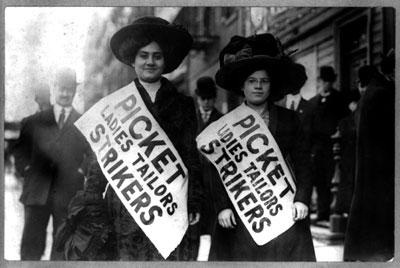
Few, if any, women picketed on strikes in Greenville. But scenes like these two garment workers were the norm other parts of Texas. We’ve come a long way in the last century. (Lumen Learning)
Two days ago, September 3, was Labor Day. So what did you do? I happened to need to finish writing the five papers I was in final stages of completing. Therefore, I worked. I suspect many went to the lake, to the mall to go shopping, to the theater to watch a movie, or something else equally enjoyable.
Dr. Jean Stuntz, a noted history professor at West Texas A&M University, posted on Facebook that many would be surprised to learn the origin of the day off. Perhaps you know that is was first known as Labor’s Holiday in 1894 when Congress made it a legal public holiday. Today it is simply Labor Day, a day to celebrate the efforts of all those who came before us to give manual laborers such things as eight-hour work days, 40-hour work weeks, paid vacations, employee health benefits, worker safety laws, compensation for on-the-job injuries and other benefits. Driving these issues were Socialists such as Eugene V. Debs.
I scanned through city directories for 1913 and 1922. Then I googled “labor unions in Greenville, Texas.” Today we have one United Auto Workers (UAW) group in town with 918 members. All seem to be employed by the defense plant that has been here since the 1950s. Because of its secrecy, the average citizen has only a vague idea of what goes on in the big complex at the edge of town. However, we know many people who work there. Strikes are not common today.
What about labor unions in 1913 and 1922? I have no numbers for membership but I do know that in both years railroad employees were leaders in the labor movement in Greenville, Texas. In both years there were four railway lines in and out of Greenville, a hub for the thriving cotton industry. So it was not surprise that Brotherhood of Locomotive Engineers, Brotherhood of Railway Carmen, and Brotherhood of Railway Trainmen were active throughout the nine year time period.
Not only were railroad employees involved in labor unions but also so were Greenville Typographers and unions for movie theater projectionists. A survey of local newspapers shows all of these unions went on strike at least once. None lasted for any length of time.
The Ancient Order of United Workmen (AOUW) was listed only in 1913. This group was open to any laborers and provided mutual social and financial support for members. Similar to Woodmen of the World for farmers, it offered insurance for sickness, accidents, death, and burial policies. No interaction between employers and employees on safety, hourly wages, etc. was a part of this organization.
The more drastic measures in unions stand to big business seemed to have centered on large cities or company towns. Greenville was a mixture of tenant farmers, small industry, railroads, bankers, and cotton buyers. The problems were there but leadership was not.
